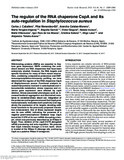Mostrar el registro sencillo del ítem
The regulon of the RNA chaperone CspA and its auto-regulation in Staphylococcus aureus
| dc.creator | Caballero Sánchez, Carlos | es_ES |
| dc.creator | Menéndez Gil, Pilar | es_ES |
| dc.creator | Catalán Moreno, Arancha | es_ES |
| dc.creator | Vergara Irigaray, Marta | es_ES |
| dc.creator | García Martínez, Begoña | es_ES |
| dc.creator | Segura, Víctor | es_ES |
| dc.creator | Irurzun Domínguez, Naiara | es_ES |
| dc.creator | Villanueva San Martín, Maite | es_ES |
| dc.creator | Ruiz de los Mozos Aliaga, Igor | es_ES |
| dc.creator | Solano Goñi, Cristina | es_ES |
| dc.creator | Lasa Uzcudun, Íñigo | es_ES |
| dc.creator | Toledo Arana, Alejandro | es_ES |
| dc.date.accessioned | 2018-09-06T12:20:12Z | |
| dc.date.available | 2018-09-06T12:20:12Z | |
| dc.date.issued | 2018 | |
| dc.identifier.issn | 0305-1048 (Print) | |
| dc.identifier.issn | 1362-4962 (Electronic) | |
| dc.identifier.uri | https://hdl.handle.net/2454/30527 | |
| dc.description.abstract | RNA-binding proteins (RBPs) are essential to finetune gene expression. RBPs containing the coldshock domain are RNA chaperones that have been extensively studied. However, the RNA targets and specific functions for many of them remain elusive. Here, combining comparative proteomics and RBPimmunoprecipitation- microarray profiling, we have determined the regulon of the RNA chaperone CspA of Staphylococcus aureus. Functional analysis revealed that proteins involved in carbohydrate and ribonucleotide metabolism, stress response and virulence gene expression were affected by cspA deletion. Stress-associated phenotypes such as increased bacterial aggregation and diminished resistance to oxidative-stress stood out. Integration of the proteome and targetome showed that CspA posttranscriptionally modulates both positively and negatively the expression of its targets, denoting additional functions to the previously proposed translation enhancement. One of these repressed targets was its own mRNA, indicating the presence of a negative post-transcriptional feedback loop. CspA bound the 5 UTR of its own mRNA disrupting a hairpin, which was previously described as an RNase III target. Thus, deletion of the cspA 5 UTR abrogated mRNA processing and auto-regulation. We propose that CspA interacts through a U-rich motif, which is located at the RNase III cleavage site, portraying CspA as a putative RNase III-antagonist. | en |
| dc.description.sponsorship | European Research Council (ERC) under the European Union’s Horizon 2020 research and innovation programme [646869]; Spanish Ministry of Economy and Competitiveness [BFU2011-23222, BIO2014-53530-R, BFU2014-56698-P]; Spanish National Research Council [CSIC-PII-201540I013]; C.J.C. was supported by predoctoral contract from the Public University of Navarre (UPNA), Spain. Funding for open access charge: European Research Council (ERC) under the European Union’s Horizon 2020 research and innovation programme [646869]. | en |
| dc.format.mimetype | application/pdf | en |
| dc.language.iso | eng | en |
| dc.publisher | Oxford University Press | en |
| dc.relation.ispartof | Nucleic Acids Research, 2018, Vol. 46, No. 3 1345–1361 | en |
| dc.rights | © The Author(s) 2018. This is an Open Access article distributed under the terms of the Creative Commons Attribution License, which permits non-commercial re-use, distribution, and reproduction in any medium, provided the original work is properly cited. For commercial re-use, please contact journals.permissions@oup.com | en |
| dc.rights.uri | https://creativecommons.org/licenses/by-nc/4.0/ | |
| dc.subject | RNA chaperone CspA | en |
| dc.subject | Staphylococcus aureus | en |
| dc.title | The regulon of the RNA chaperone CspA and its auto-regulation in Staphylococcus aureus | en |
| dc.type | info:eu-repo/semantics/article | en |
| dc.type | Artículo / Artikulua | es |
| dc.contributor.department | IdAB. Instituto de Agrobiotecnología / Agrobioteknologiako Institutua | es |
| dc.rights.accessRights | info:eu-repo/semantics/openAccess | en |
| dc.rights.accessRights | Acceso abierto / Sarbide irekia | es |
| dc.identifier.doi | 10.1093/nar/gkx1284 | |
| dc.relation.projectID | info:eu-repo/grantAgreement/European Commission/Horizon 2020 Framework Programme/646869 | en |
| dc.relation.projectID | info:eu-repo/grantAgreement/ES/6PN/BFU2011-23222 | en |
| dc.relation.projectID | info:eu-repo/grantAgreement/MINECO//BIO2014-53530-R/ES/ | en |
| dc.relation.projectID | info:eu-repo/grantAgreement/MINECO//BFU2014-56698-P/ES/ | en |
| dc.relation.publisherversion | https://doi.org/10.1093/nar/gkx1284 | |
| dc.type.version | info:eu-repo/semantics/publishedVersion | en |
| dc.type.version | Versión publicada / Argitaratu den bertsioa | es |
| dc.contributor.funder | Universidad Pública de Navarra / Nafarroako Unibertsitate Publikoa | es |
Ficheros en el ítem
Este ítem aparece en la(s) siguiente(s) colección(ones)
La licencia del ítem se describe como © The Author(s) 2018. This is an Open Access article distributed under the terms of the Creative Commons Attribution License, which
permits non-commercial re-use, distribution, and reproduction in any medium, provided the original work is properly cited. For commercial re-use, please contact
journals.permissions@oup.com



